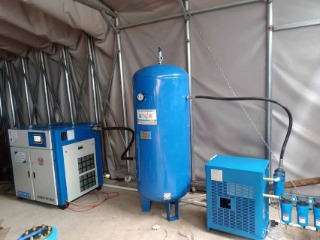Screw air compressors are widely used in various industries due to their high efficiency, reliability, and versatility. This article aims to provide an in-depth analysis of the construction principles and characteristics of screw air compressors, highlighting their functionality and advantages in the field of English.

1. Overview of Screw Air Compressor:
A screw air compressor is a positive displacement machine that converts mechanical energy into compressed air. It consists of two interlocking screws, known as rotors, housed within a chamber. As the rotors rotate, the air is compressed and discharged through the outlet.
2. Construction Principles:
2.1 Rotors: The heart of a screw air compressor is its rotors. These rotors have a unique helical shape, allowing them to mesh together and create a seal. The rotors are precision-engineered to ensure minimal clearance between them, resulting in efficient compression.
2.2 Chamber: The chamber, also known as the housing or casing, encloses the rotors. It is designed to withstand high pressure and minimize air leakage. The chamber is typically made of cast iron or steel, ensuring durability and stability.
2.3 Bearings: Screw air compressors rely on bearings to support the rotating shafts. These bearings are strategically positioned to reduce friction and ensure smooth operation. High-quality bearings are used to withstand heavy loads and provide long-lasting performance.
2.4 Drive System: The drive system of a screw air compressor comprises an electric motor or an internal combustion engine. It provides the necessary power to rotate the rotors, thereby compressing the air. Advanced control systems regulate the speed and performance of the drive system for optimal operation.
3. Characteristics:
3.1 Continuous Operation: Screw air compressors can operate continuously without the need for frequent breaks. This makes them suitable for applications that demand a constant supply of compressed air, such as pneumatic tools and industrial processes.
3.2 High Efficiency: Screw air compressors offer high efficiency due to their positive displacement design. They deliver a consistent airflow with minimal pressure fluctuations, resulting in improved productivity and reduced energy consumption.
3.3 Low Noise and Vibration Levels: Compared to other types of compressors, screw air compressors are known for their quiet operation. The helical rotors and advanced engineering techniques minimize noise and vibration, ensuring a comfortable working environment.
3.4 Compact Size: Oil injected air compressor are compact and space-efficient. Their design allows for easy installation and integration into existing systems, making them suitable for various applications, including automotive, manufacturing, and construction industries.
Screw air compressors are versatile and reliable machines that play a crucial role in various industries. Their unique construction principles, such as interlocking rotors and high-quality bearings, contribute to their efficiency, continuous operation, low noise levels, and compact size. Understanding the construction principles and characteristics of screw air compressors is essential for English professionals seeking to utilize this technology effectively.